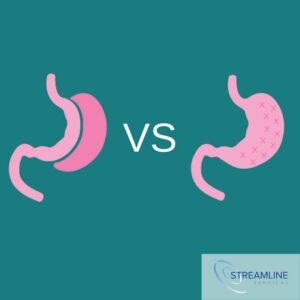Endoscopic Gastric Sleeve Vs Traditional Gastric Sleeve
 At Streamline Surgical, not only do we offer traditional gastric sleeve surgery, but we also offer a new, less-invasive alternative – the Endoscopic Gastric Sleeve, also known as an Endoscopic Sleeve Gastroplasty or ESG for short.
At Streamline Surgical, not only do we offer traditional gastric sleeve surgery, but we also offer a new, less-invasive alternative – the Endoscopic Gastric Sleeve, also known as an Endoscopic Sleeve Gastroplasty or ESG for short.
So, what is the difference between the Endoscopic Gastric Sleeve and the traditional Gastric Sleeve?
Traditional Gastric Sleeve Surgery is an irreversible procedure that reduces the volume of the stomach. This surgery is conducted by keyhole surgery to remove 90% of the stomach, changing the stomach from an expandable reservoir for eaten food, to a narrow tube approximately 1cm in diameter.
The Endoscopic Gastric Sleeve is a reversible procedure carried out by endoscope – this is when a long flexible telescope is passed through the mouth and into the stomach cavity. Sutures (stitches) are then made to the internal stomach wall via the endoscopic device, creating a tube-shaped stomach and reducing its capacity by 80%. This procedure can be reversed by removing the sutures.
What are the pros and cons of each procedure?
Both weight loss procedures share many advantages, for example:
- Both restrict the amount of food that can be held in the stomach
- Reduces the amount of hunger hormone (ghrelin) that is produced by the stomach, reducing appetite
- Encourages rapid and significant weight loss
- On average, patients lose about 60-70% of their extra weight
Whilst they both have very similar outcomes, the procedures have some stand out differences when it comes to their pros and cons.
The Endoscopic Gastric Sleeve is a less invasive procedure than the traditional gastric sleeve, as it does not involve making any incisions in the stomach and does not remove any sections of the stomach. Instead, this procedure uses sutures (stitches) to mold the stomach into a thin tube-like shape, whilst leaving the remaining stomach in place, meaning that the procedure is reversible – unlike the traditional gastric sleeve where part of the stomach is physically removed.
The recovery time for the Endoscopic Gastric Sleeve is quicker than that of the traditional gastric sleeve, with the ESG only requiring a one night stay in hospital rather than two. Also, patients don’t have to wait for external abdominal scars to heal before participating in physical activity.
Whilst there are many clear advantages to the new ESG procedure, case study data is limited due to it being a relatively new procedure, but the current data is extremely promising.
What are the risks of each procedure?
As with any surgery, these weight loss procedures both carry risks, with ESG patients potentially experiencing mild nausea and abdominal discomfort for a week after the procedure.
There is a 1 in 1000 risk of perforation of the stomach, causing peritonitis, which may require surgery and a 1 in 5000 risk of bleeding from the stomach that might require further treatment.
With the traditional gastric sleeve, the most serious complication is a leak from the staple line, which occurs in between 1 and 3% of patients.
If you would prefer a less invasive weight loss surgery option, enquire about the Endoscopic Gastric Sleeve. It is potentially suitable for most individuals with a low to moderately raised BMI of 30 to 45 kg/m2 and is a weight loss option for those individuals who want to avoid conventional weight loss surgery, like the traditional gastric sleeve, bypass or band.
By speaking with a trained professional, they can help you to understand what weight loss surgery option is best for you.
To enquire with Streamline Surgical about the ESG procedure or other weight loss procedures that we offer, please fill in our website enquiry form or call 0333 016 3030.
